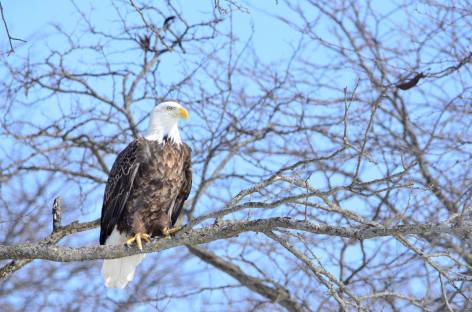
Iowa State University researchers found that few free-flying bald eagles in the state suffer from high levels of lead exposure. Photo by Billy Reiter-Marolf. Larger image.
AMES, Iowa – A first-of-its-kind study of Iowa bald eagles found that only a small fraction of the birds appear to suffer from high levels of lead exposure, according to Iowa State University researchers.
Many bald eagles receive treatment at Iowa wildlife rehabilitation centers for lead exposure each year. It’s thought that most of the birds come into contact with lead by scavenging deer carcasses that have been shot with lead bullets or shotgun pellets.
As lead builds up in an animal’s system, it can disrupt critical bodily functions, slow growth and development or even result in death. But the ISU study is the first to investigate the prevalence of lead exposure among the general population of bald eagles in the state rather than just sick birds that are admitted to wildlife rehabilitation facilities.
“On average, we found very low levels of lead,” said Julie Blanchong, an associate professor of natural resource ecology and management who led the study. “Only a very small proportion of samples had high levels of lead.”
The two-year study began in 2011. The researchers obtained the necessary state and federal permits to visit more than 100 bald eagle nests across the state, mostly in northeast Iowa where the majority of bald eagles are concentrated. Then they collected excrement on the ground and tree bark below the nests and tested the samples for lead.
Blood samples are generally the preferred method of determining lead exposure in animals, but when the subject of the testing is a tree-dwelling bird with sharp talons and a beak, you have to make some logistical concessions, said Stephen Dinsmore, a professor of natural resource ecology and management who worked on the project.
Blanchong and Dinsmore also worked with the MacBride Raptor Center near Solon, the Saving Our Avian Resources organization and the ISU Wildlife Care Clinic to test eagles admitted for rehabilitation for lead and compare excrement lead levels to blood lead levels. Lead levels in the rehabilitation birds were considerably higher than what they found for most free-flying eagles.
“Any amount of lead in an animal is unnatural and a negative thing, but it’s encouraging to know that most free-flying eagles are not experiencing the high levels of lead exposure we see in rehabilitation patients,” Blanchong said.